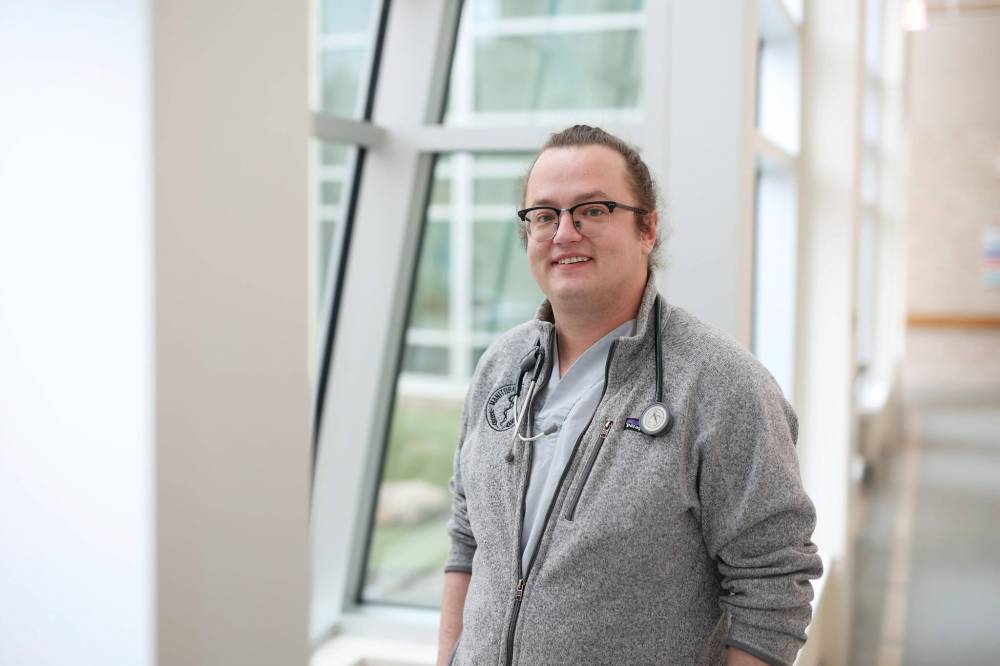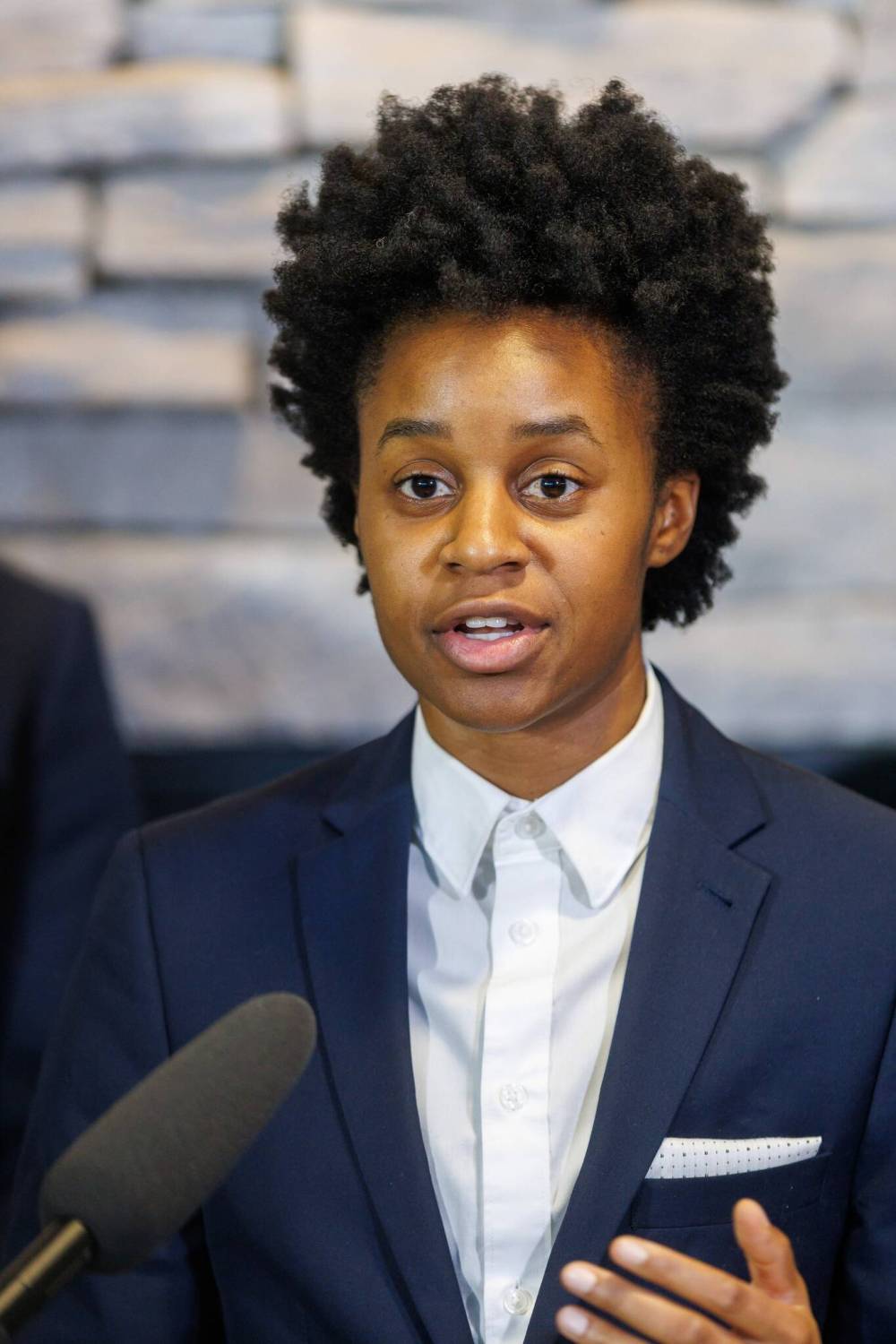Manitoba will fill a record number of medical residencies this summer and expects it to pay off by having more doctors stay and set up their practice in the province.
“Our goal is to get people here in Manitoba, show them how great it is to be in Manitoba, and then keep them here,” said Dr. Peter Nickerson, University of Manitoba vice-provost (health sciences) at a news conference Wednesday at the Max Rady College of Medicine.
“This is a big deal,” Health Minister Uzoma Asagwara said. “We are on track to meet our target of 400 physicians added to our health-care system in four years.”
On July 1, 173 medical school graduates will begin two-year residencies across Manitoba; that’s 17 more than last year, when three of those seats were unfilled, Nickerson said.
An estimated 73 per cent of U of M medical school grads choose to stay and do their residency in Manitoba, where they get a range of experiences they’re unlikely to have in a large urban setting or elsewhere, he said.

Tim Smith/The Brandon Sun
Stefon Irvin’s goal is to have a “full-scope” family medicine practice in northern Manitoba when he completes his two-year residency in 2026.
When Stefon Irvin completes his two-year residency in 2026, his goal is to have a “full-scope” family medicine practice in northern Manitoba: from “birth to death” and all the “lumps and bumps” and “regular health maintenance appointments” in between, he said.
“My goal has been to return to the north and provide health care in the north,” said the 31-year-old who is one of five Indigenous grads to join the remote northern family residency program. It includes stints in communities throughout northern Manitoba as well as Nunavut.
Seventy-eight of the 173 medical residents are Manitobans, 52 are from elsewhere in Canada and 43 are from outside Canada.
In terms of family medicine, 72 have decided to specialize in that field — an increase from 52 two years ago. The number is expected to grow to 82 next year.
“My goal has been to return to the north and provide health care in the north.”–Stefon Irvin
The government boosted funding to increase the number of rural and northern medicine residencies to 48 from 34 in 2023.
The hope is that it will bolster future coverage in under-served communities.
“We know that wherever you practise and learn is where you tend to practise after training,” Nickerson said.
“It’s a strategy for getting our residents into communities so that, hopefully, they’ll stay there.”
Irvine, a former psychiatric nurse who is Métis, was born in Flin Flon and raised in northern Manitoba, said he decided to become a doctor to play a greater role in helping to change the health care system and to advocate for northerners.
The U of M medical school grad did much of his training in Thompson, Brandon and several First Nations including Norway House Cree Nation.
“My biggest goal is to find my community and really integrate myself into the community,” said Irvine, who’s a first-generation university graduate in his family and can formally add the prefix Dr. to his name after graduating May 16.
“A lot of medicine doesn’t happen in the clinic, it happens as a community, as whole,” he said.
Irvine applauded the U of M’s recruitment of Indigenous medical students and for producing grads and doctors who’ve been at the forefront of implementing the Truth and Reconciliation Commission’s calls to action. “We’re really seeing the fruits of those changes.”

Mike Deal / Free Press files
Health Minister Uzoma Asagwara: “This is a big deal.”
The number of medical residents is expected to grow to 190 next year, with an increase in funding and more opportunities for family doctors to take on residents across the province: “Who is capable to take on a family resident for two years while they’re in their training?” Nickerson said.
“This year we have two family residents going to Neepawa where we’ve never had family residents,” he said.
The U of M is careful to not ask physicians to take on too much or too many residents, said Nickerson. “It’s about sustainable growth.”
The health minister said that in addition to adding residency positions in rural and northern Manitoba, the government is “addressing the critical need for accessible medical services in these communities.”
The expansion of the number of residencies requires the University of Manitoba, municipalities, regional health authorities, doctors, nurses, allied health professionals and Doctors Manitoba to work together to recruit, train and retain and doctors, Asagwara said.
Filling 173 residencies is “another step” toward addressing the doctor shortage that has been allowed to grow for too long, said Dr. Candace Bradshaw, former president of Doctors Manitoba.
She said her 1999 medical school graduating class was among the smallest in Manitoba in decades after governments across Canada had for years cut medical school training.
“It’s no surprise today that Canada has among the lowest number of doctors per capita amongst developed nations,” she said.
Currently, 200,000 Manitobans don’t have a family doctor, many rural communities are without an emergency room and Winnippegers deal with “unreasonably long” waits at the ER, to see a specialist or get surgery, Bradshaw said.
“Government decisions have lasting impacts,” said the doctor.
“I’m happy to be here today to celebrate the largest number ever of resident doctors set to begin a residency in Manitoba his summer. This is a decision that has the potential to have a lasting impact in a very good way.”
She said Doctors Manitoba will launch a program next week to support and mentor new doctors as they transition into a practice when they need it most in their first five years.
The organization, she said, is reaching out to its members about changes to the capital gains tax announced in the federal budget. Some physicians whose practice is their retirement nest egg have expressed concern they may be in for a financial hit as a result.
“While we’re putting in all these efforts to recruit and retain, we need to really assess how this could potentially affect (such efforts),” Bradshaw said.
carol.sanders@freepress.mb.ca

Carol Sanders
Legislature reporter
After 20 years of reporting on the growing diversity of people calling Manitoba home, Carol moved to the legislature bureau in early 2020.